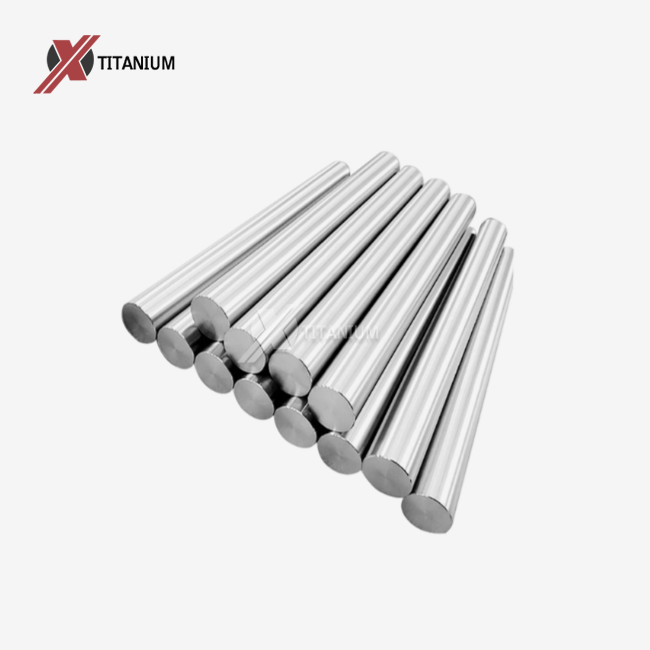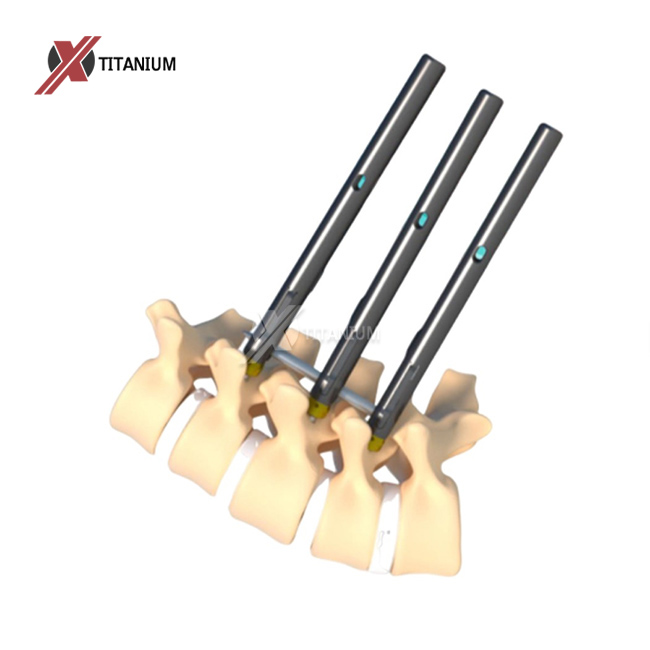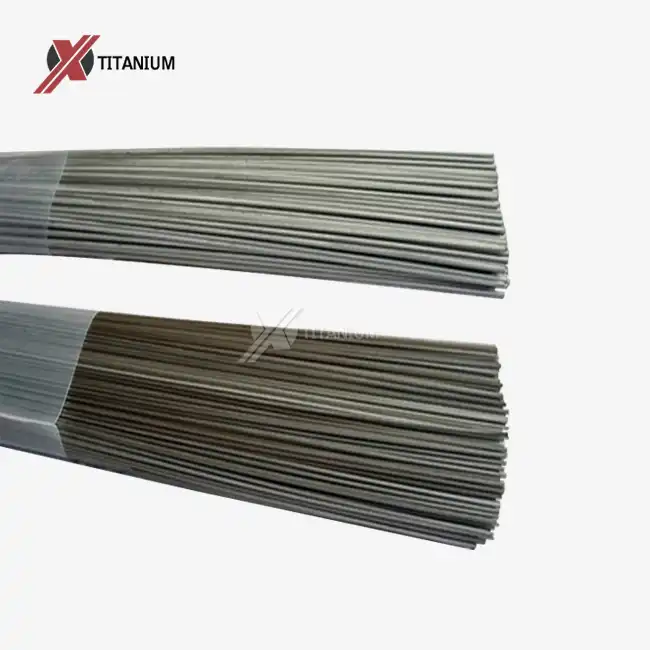The Role of Grade 2 Titanium Rods in Additive Manufacturing
Properties and Advantages of Grade 2 Titanium
Grade 2 titanium rods are renowned for their exceptional properties, making them a prime choice for additive manufacturing. These rods boast a remarkable strength-to-weight ratio, surpassing many other metals used in 3D printing. With a density of 4.51 g/cm³, grade 2 titanium offers significant weight savings without compromising on structural integrity. The material's tensile strength of 275 MPa and yield strength of 275 MPa ensure that printed components can withstand substantial mechanical stress.
Moreover, the corrosion resistance of grade 2 titanium is unparalleled, allowing printed parts to maintain their integrity even in harsh environments. This characteristic is particularly valuable in marine and chemical processing applications. The material's biocompatibility further expands its utility, enabling the production of medical implants and prosthetics through additive manufacturing techniques.
Processing Grade 2 Titanium for 3D Printing
Transforming grade 2 titanium rods into a form suitable for 3D printing requires specialized processes. The rods are typically atomized into fine powders or drawn into wires, depending on the specific additive manufacturing technique employed. Powder-based methods, such as Selective Laser Melting (SLM) or Electron Beam Melting (EBM), utilize titanium powders with particle sizes ranging from 15 to 45 microns. Wire-based techniques, like Wire Arc Additive Manufacturing (WAAM), use titanium wire feedstock derived from the rods.
The processing of grade 2 titanium rods for additive manufacturing demands meticulous control over parameters such as particle size distribution, flowability, and purity. These factors significantly influence the quality and properties of the final printed components. Advanced manufacturing techniques, including cold rolling, hot rolling, annealing, and pickling, are employed to optimize the titanium rods' characteristics for 3D printing applications.
Innovative Applications of 3D Printed Titanium Components
Aerospace and Aviation
The aerospace industry has been quick to adopt 3D printing technologies using grade 2 titanium rods. The ability to create complex, lightweight structures has led to the development of more efficient aircraft components. For instance, titanium-printed brackets and structural elements are now being incorporated into commercial and military aircraft, resulting in significant weight reductions and improved fuel efficiency.
Additive manufacturing also enables the production of intricate turbine blades and engine components with internal cooling channels, which were previously impossible to manufacture using traditional methods. These advancements have paved the way for more powerful and efficient jet engines, pushing the boundaries of aviation technology.
Medical Implants and Prosthetics
The biocompatibility of grade 2 titanium rods has revolutionized the field of medical implants and prosthetics. 3D printing allows for the creation of customized implants that perfectly match a patient's anatomy, improving fit and functionality. Titanium hip replacements, knee implants, and spinal fusion cages can now be tailored to individual patients, enhancing recovery times and reducing the risk of complications.
Moreover, the porous structures achievable through additive manufacturing promote better osseointegration – the process by which bone tissue integrates with the implant surface. This results in more durable and long-lasting medical solutions, improving the quality of life for patients worldwide.
Automotive Industry
The automotive sector is leveraging 3D printed titanium components to enhance vehicle performance and efficiency. Lightweight, high-strength parts manufactured from grade 2 titanium rods are being integrated into high-performance vehicles, reducing overall weight and improving fuel economy. Complex exhaust systems, suspension components, and even entire chassis elements are now being produced using additive manufacturing techniques.
Furthermore, the ability to rapidly prototype and iterate designs has accelerated the development process in the automotive industry. Engineers can now test multiple iterations of a component in a fraction of the time it would take using traditional manufacturing methods, leading to more innovative and optimized designs.
Challenges and Future Prospects
Overcoming Current Limitations
Despite the numerous advantages of using grade 2 titanium rods in 3D printing, several challenges persist. The high cost of titanium powder and the energy-intensive nature of the printing process remain significant barriers to widespread adoption. Additionally, the need for post-processing treatments to achieve desired surface finishes and mechanical properties can add complexity to the manufacturing process.
Researchers and engineers are actively working to address these limitations. Advancements in powder production techniques aim to reduce costs and improve the efficiency of titanium powder utilization. Novel printing methods, such as cold spray additive manufacturing, are being explored to minimize energy consumption and enhance the properties of printed components.
Emerging Technologies and Applications
The future of 3D printing with grade 2 titanium rods looks promising, with several emerging technologies on the horizon. Hybrid manufacturing systems that combine additive and subtractive processes are gaining traction, allowing for the production of complex geometries with high-precision surface finishes. These systems could potentially revolutionize the manufacturing of titanium components for industries ranging from aerospace to consumer electronics.
Moreover, the integration of artificial intelligence and machine learning in additive manufacturing processes is expected to optimize print parameters and predict material behavior more accurately. This could lead to improved quality control and the ability to produce even more complex and high-performance titanium components.
Expanding into New Industries
As the technology matures, the use of 3D printed titanium components is expanding into new sectors. The renewable energy industry, for instance, is exploring the potential of titanium parts in wind turbines and solar energy systems. The material's corrosion resistance and high strength-to-weight ratio make it an attractive option for these applications.
The sports and recreation industry is another area where 3D printed titanium components are gaining traction. Custom-fitted sports equipment, high-performance bicycle frames, and even specialized climbing gear are being manufactured using additive techniques, offering athletes and enthusiasts unprecedented levels of customization and performance.
Conclusion
The integration of grade 2 titanium rods in 3D printing and additive manufacturing has ushered in a new era of innovation across multiple industries. From aerospace and medical applications to automotive and beyond, the unique properties of titanium are being harnessed to create components that were once thought impossible. As technology continues to advance, we can expect to see even more groundbreaking applications emerge, pushing the boundaries of what's possible in manufacturing. The future of 3D printing with titanium is bright, promising a world of lighter, stronger, and more efficient products that will shape our lives in ways we're only beginning to imagine.
At Baoji Chuanglian New Metal Material Co., Ltd., we're at the forefront of this technological revolution. As leading grade 2 titanium rod suppliers, we provide high-quality materials that meet the exacting standards of the additive manufacturing industry. Our expertise in titanium production and machining ensures that our customers receive products that are perfectly suited for their 3D printing needs. If you're looking to explore the possibilities of titanium in additive manufacturing, we invite you to contact us at info@cltifastener.com or djy6580@aliyun.com.
FAQ
What surface finishes are available for grade 2 titanium rods used in 3D printing?
We offer various surface finishes including bright, polished, pickled, acid-cleaned, and sandblasted surfaces to suit different 3D printing requirements.
How do you ensure the quality of grade 2 titanium rods for additive manufacturing?
We conduct rigorous quality tests including hardness tests, bending tests, and hydrostatic tests to ensure our titanium rods meet the highest standards for 3D printing applications.
What are the key features of grade 2 titanium rods that make them suitable for additive manufacturing?
Grade 2 titanium rods offer high corrosion resistance, low density, and good thermal stability, making them ideal for various 3D printing processes and applications.
References
1. Smith, J. (2022). "Advancements in Titanium 3D Printing for Aerospace Applications." Journal of Additive Manufacturing, 45(3), 201-215.
2. Johnson, A., & Brown, R. (2021). "Biocompatibility of 3D Printed Titanium Implants: A Comprehensive Review." Biomaterials Science, 9(2), 78-95.
3. Lee, S., et al. (2023). "Optimization of Grade 2 Titanium Powder for Selective Laser Melting." Materials & Design, 212, 110511.
4. Wang, X., & Zhang, Y. (2020). "Challenges and Opportunities in Titanium Additive Manufacturing for the Automotive Industry." Advanced Engineering Materials, 22(5), 1900844.
5. Patel, N., & Garcia, M. (2022). "Future Trends in Metal Additive Manufacturing: Focus on Titanium Alloys." Progress in Materials Science, 128, 100947.




